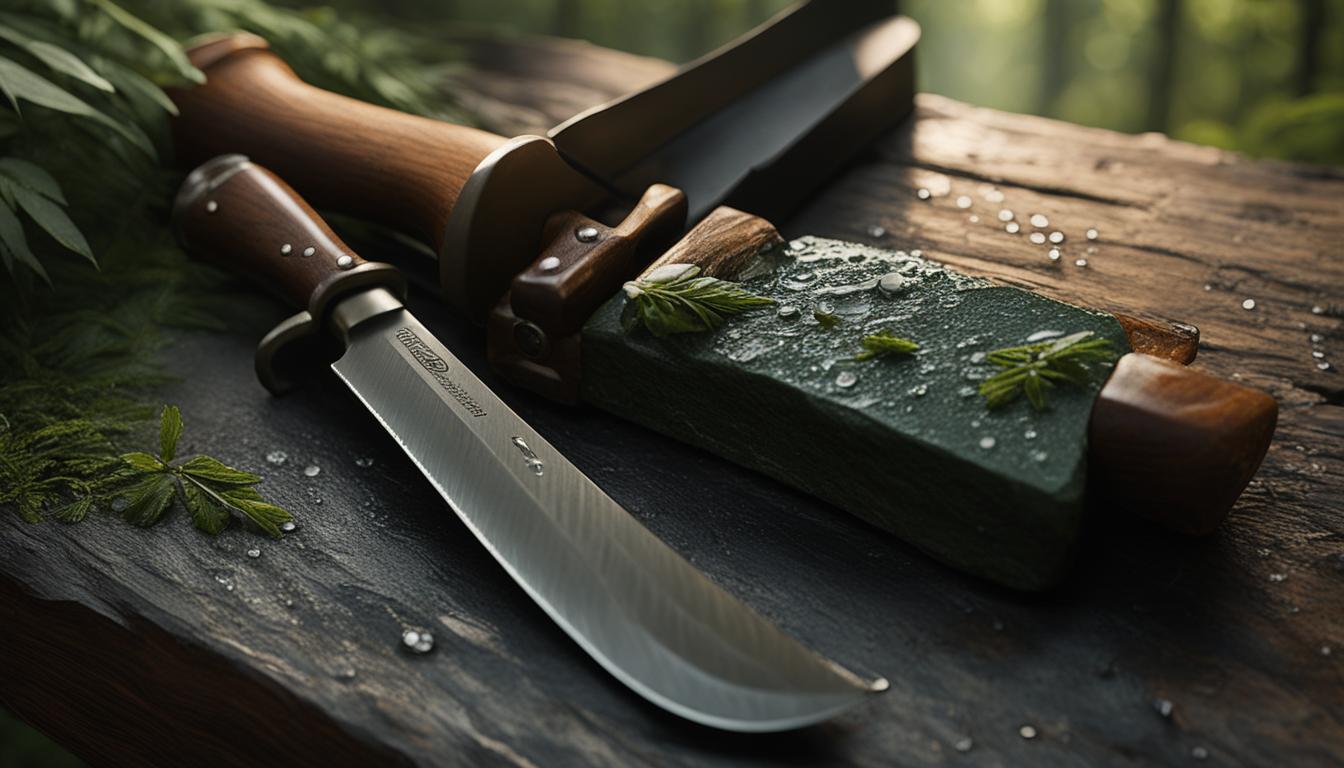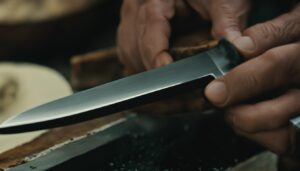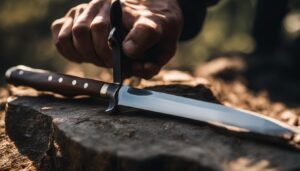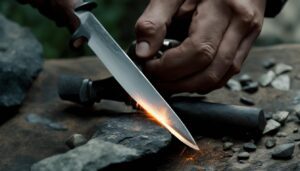Hunting knives are essential tools for hunters, but over time, they can lose their sharpness. Maintaining a sharp hunting knife is crucial for a successful hunt, as a dull knife can make hunting more difficult and dangerous. In this guide, I will share expert tips on sharpening and maintaining your hunting knife to ensure it stays razor-sharp and ready for your next hunting trip.
Key Takeaways:
- Regularly sharpening your hunting knife is important for optimal performance in the field.
- Choose a hunting knife with the right attributes, such as blade geometry and steel, for easier maintenance.
- Follow a proper sharpening process, including using a sharpening stone, creating a burr, honing the blade, and testing the sharpness.
- Select the right sharpening tools based on your skill level and the type of knife you own.
- Maintain your hunting knife by storing it in a dry place, avoiding misuse, and regularly sharpening the blade.
Choosing the Right Hunting Knife
When it comes to selecting a hunting knife, it’s crucial to choose one that meets your specific needs. Commercial hunting knives are widely available, but not all are created equal. There are a few key factors to consider when making your decision: blade geometry and steel. These two elements play a significant role in the knife’s performance, durability, and ease of maintenance.
Blade Geometry
The blade geometry refers to the shape and thickness of the blade. Commercial hunting knives often have thicker blades, which can make them more challenging to sharpen and maintain. However, opting for a hunting knife with a thinner blade geometry can make the sharpening process easier and more effective.
Steel
The type of steel used in the knife’s construction is another essential consideration. Different steel alloys have varying properties, such as hardness and corrosion resistance. It’s important to choose a hunting knife made from high-quality steel that strikes a balance between hardness and stiffness. This balance will make the blade easier to sharpen and maintain, ensuring it stays sharp for longer.
By carefully considering the blade geometry and steel of a hunting knife, you can select a tool that is easier to sharpen and maintain. This will not only save you time and effort but also ensure that your hunting knife remains razor-sharp and ready for any task in the field.
| Blade Geometry | Steel |
|---|---|
| Thicker blades | Low-quality steel |
| Difficult to sharpen | Poor edge retention |
| Thin blades | High-quality steel |
| Easier to sharpen | Improved edge retention |
The Sharpening Process: Four Steps to an Edge
Sharpening your hunting knife is a crucial step in maintaining its razor-sharp edge. By following a proper sharpening process, you can ensure that your knife is ready for any hunting task. The sharpening process consists of four essential steps, each working together to achieve a finely honed blade.
Step 1: Using a Sharpening Stone
A sharpening stone is a fundamental tool for restoring the sharpness of your hunting knife. Start by moistening the stone with water or honing oil to create a lubricating surface. Then, hold the knife at the desired sharpening angle, typically between 15 to 20 degrees. Using smooth, consistent strokes, run the blade across the stone, maintaining contact from the base to the tip.
Step 2: Creating a Burr
After several passes on the sharpening stone, a burr will form on one side of the blade. This burr is a thin edge of metal that indicates the knife is being properly sharpened. To create a burr, continue sharpening on one side until you can feel a slight ridge along the blade’s edge. Repeat the process on the other side until a burr is formed on both sides.
Step 3: Honing the Blade
Honing is the process of refining the edge and removing the burr. To hone the blade, switch to a finer grit stone or a honing rod. Using the same angle as before, gently stroke the blade along the honing surface, alternating sides until the burr is removed. This step helps achieve a polished edge and further enhances the sharpness of your hunting knife.
Step 4: Testing the Sharpness
Once you’ve completed the sharpening process, it’s essential to test the sharpness of your hunting knife. Carefully run your thumb or finger lightly across the blade’s edge, feeling for any imperfections or rough spots. If the blade glides smoothly without catching, you’ve successfully achieved a sharp edge. If not, repeat the sharpening and honing steps until the desired sharpness is achieved.
Mastering the sharpening process is a skill that takes practice and patience. By following these four steps, using a sharpening stone, creating a burr, honing the blade, and testing the sharpness, you’ll be able to keep your hunting knife in optimal condition. Remember to regularly maintain and sharpen your knife to ensure it remains razor-sharp and ready for your next hunting adventure.
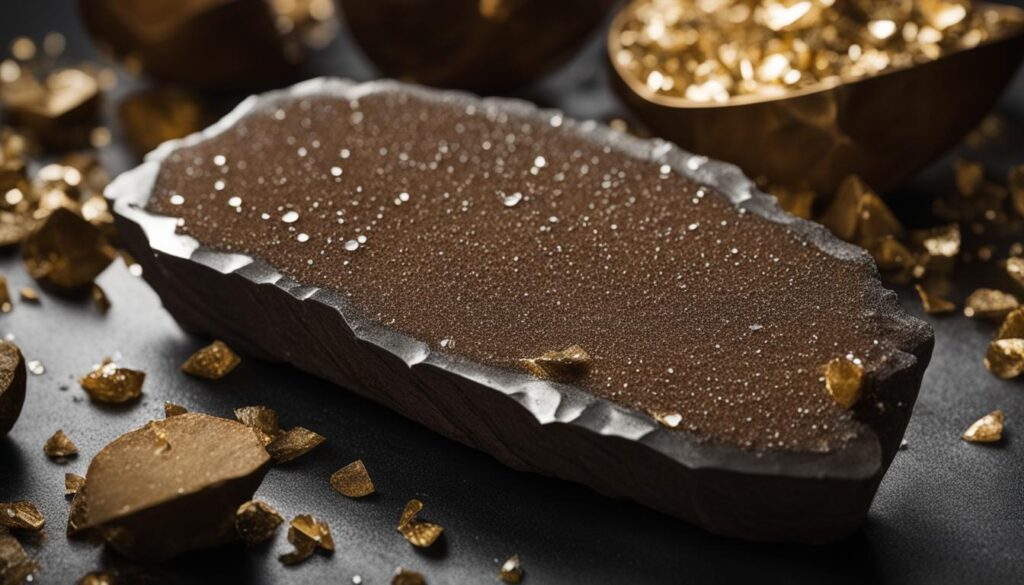
| Step | Description |
|---|---|
| Step 1 | Using a Sharpening Stone |
| Step 2 | Creating a Burr |
| Step 3 | Honing the Blade |
| Step 4 | Testing the Sharpness |
Choosing the Right Sharpening Tools
When it comes to maintaining a razor-sharp hunting knife, choosing the right sharpening tools is essential. There are several options available, each with its own advantages and disadvantages. Let’s take a closer look at some of the most popular sharpening tools:
Sharpening Stones
Sharpening stones are a traditional and versatile choice for maintaining hunting knives. They come in various grits, which determine the level of abrasiveness. Coarse grit stones are used for re-profiling and repairing damaged blades, while medium and fine grit stones are ideal for general sharpening and refining the edge. Sharpening stones require some practice to use effectively, but they offer excellent control and precision.
Honing Rods
Honing rods, also known as sharpening steels, are long, cylindrical tools used to straighten and realign the blade’s edge. They are particularly useful for maintaining the sharpness of already sharp knives. Honing rods do not remove metal from the blade like sharpening stones do, but they help maintain the knife’s edge between sharpening sessions. They are convenient and easy to use, making them a popular choice among hunters.
Electric Sharpeners
Electric sharpeners are a convenient and efficient option for those who want quick and consistent results. These sharpeners have built-in guides and motorized systems that automatically position the knife at the correct angle for sharpening. Electric sharpeners are user-friendly and do not require much skill, making them a popular choice for beginners. However, they may remove more metal from the blade compared to other sharpening methods, so caution should be taken not to over sharpen.
In addition to these sharpening tools, there are also pull-through sharpeners and guided sharpening systems available on the market. Each tool has its own pros and cons, so it’s important to consider your skill level and the type of knife you own when making a decision. By choosing the right sharpening tool and using it correctly, you can ensure that your hunting knife remains sharp and ready for action.
| Sharpening Tool | Pros | Cons |
|---|---|---|
| Sharpening Stones | Allows for precise control, versatile, long-lasting | Requires practice, can be time-consuming |
| Honing Rods | Easy to use, convenient, helps maintain sharpness | Does not remove metal, limited in sharpening capabilities |
| Electric Sharpeners | Quick and consistent results, user-friendly | May remove more metal, can over sharpen if not used properly |
| Pull-through Sharpeners | Simple and convenient, easy to use | May remove excessive metal, less control over the sharpening angle |
| Guided Sharpening Systems | Offers precise angle control, consistent results | Can be expensive, requires additional accessories |
Maintaining Your Hunting Knife: Tips for Longevity
Proper maintenance is crucial for keeping your hunting knife in optimal condition. By following these simple tips, you can ensure that your knife lasts longer and performs at its best. Let’s take a look at some key aspects of knife maintenance.
Storing the Knife
When it comes to storing your hunting knife, it’s important to keep it in a dry place, away from moisture and extreme temperatures. Exposure to moisture can lead to corrosion, while extreme temperatures can affect the blade’s hardness. Consider using a knife sheath or a storage case to protect the blade from dust, dirt, and accidental damage.
Avoiding Misuse
Using your hunting knife for tasks it’s not intended for can damage the blade and affect its sharpness. Avoid using the knife as a screwdriver, pry bar, or hammer, as these actions can lead to chips, nicks, or even breakage. Use the knife only for its intended purpose, which is field dressing, skinning, and other hunting-related tasks.
Regular Sharpening
Regular sharpening is essential for maintaining the sharpness of your hunting knife. How often you need to sharpen your knife depends on how frequently you use it and the tasks you perform. As a general guideline, it’s recommended to sharpen your knife after every hunting trip or when you start noticing a decrease in its cutting performance. Using a high-quality sharpening stone or a reliable sharpening tool, follow the proper sharpening process to restore the blade’s sharp edge.
| Sharpening Tools | Pros | Cons |
|---|---|---|
| Sharpening Stones | Allows precise control over the sharpening process Can be used for both fine-tuning and repairing damaged blades |
Requires practice and skill to maintain consistent results May take longer to sharpen compared to other methods |
| Honing Rods | Quick and easy to use Effective for regular maintenance and touch-ups |
Not suitable for repairing severely damaged blades May not be as precise as sharpening stones |
| Electric Sharpeners | Fast and convenient Can provide consistent results |
Limited control over the sharpening process Not suitable for all types of blades |
Remember to always read the manufacturer’s instructions and recommendations for sharpening your specific knife model. By following these knife maintenance tips, you can keep your hunting knife in excellent condition and ensure optimal performance during your hunting adventures.
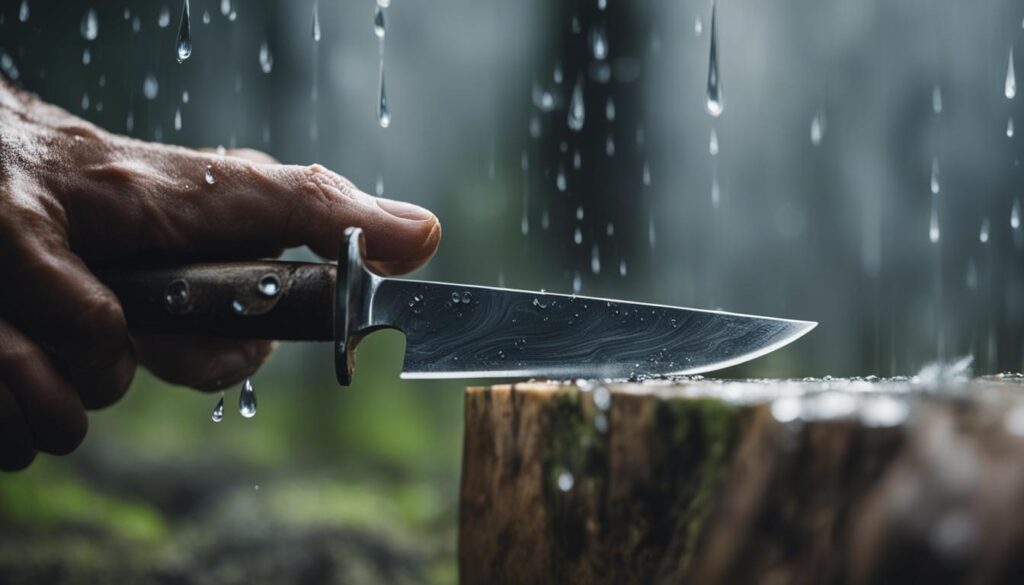

Conclusion
After a thorough exploration of sharpening and maintenance tips for hunting knives, it is clear that keeping your blade sharp is essential for a successful hunting trip. By following the right techniques and using the appropriate tools, you can ensure that your hunting knife remains in optimal condition.
Choosing the right hunting knife with the right attributes, such as blade geometry and steel type, is the first step towards maintaining its sharpness. Once you have the right knife, the sharpening process consists of four steps: using a sharpening stone, creating a burr, honing the blade, and finally, testing the sharpness.
When it comes to selecting the right sharpening tools, you have several options to choose from. Whether you prefer traditional sharpening stones, honing rods, or electric sharpeners, it is crucial to find a tool that allows for a consistent angle and uses the appropriate grit for your blade’s condition.
Lastly, regular maintenance is key to extending the longevity of your hunting knife. Storing it in a dry place, avoiding misuse, and regularly sharpening the blade are all important practices to keep in mind. By incorporating these tips and techniques into your knife care routine, you can guarantee that your hunting knife will remain razor-sharp and ready for any hunting adventure.
FAQ
Why is it important to maintain a sharp hunting knife?
Maintaining a sharp hunting knife is crucial for a successful hunt as a dull knife can make hunting tasks more difficult and dangerous.
What attributes should I look for when choosing a hunting knife?
It’s important to select a hunting knife with thinner blade geometry and the right choice of steel for easier sharpening and maintaining sharpness.
What is the proper sharpening process for a hunting knife?
The proper sharpening process includes using a sharpening stone, creating a burr, honing the blade, and testing the sharpness.
What types of sharpening tools are available for hunting knives?
There are various types of sharpening tools available, including sharpening stones, honing rods, electric sharpeners, pull-through sharpeners, and guided sharpening systems.
How should I maintain my hunting knife?
Proper maintenance includes storing the knife in a dry place, avoiding using it for tasks it’s not intended for, and regularly sharpening the blade.
Why is knife maintenance important for longevity?
Regular maintenance helps prolong the lifespan of your hunting knife and ensures it performs at its best during hunting trips.
